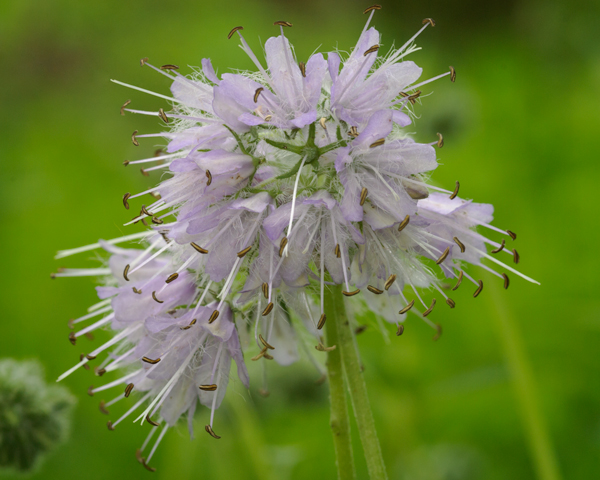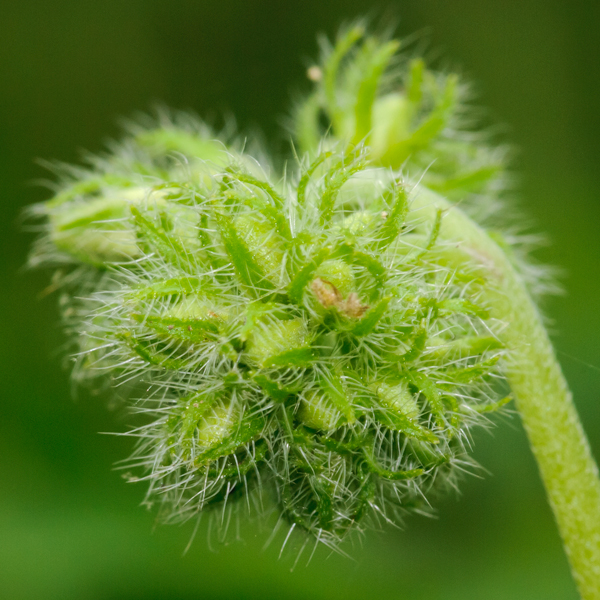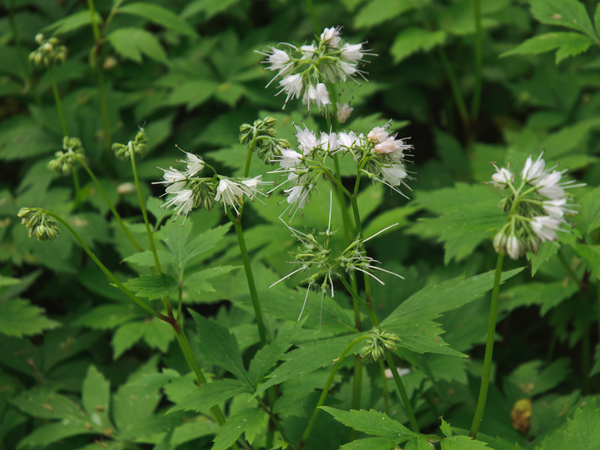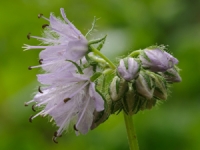
Waterleaf flowers look messy. They grow in dense clusters of eight to twenty blossoms with stamens and pistils that protrude far beyond the petals, daring you to make sense of it all. These clusters are called cymes and are held on thick stalks up above the leaves. The flowers have five petals and grow in short bells, maybe half-an-inch long. They vary in color, even in one area, from white to lavender to blue to purple.
Thick, dark anthers cap off the filaments of the stamens like the top line of a T. The stamens and sepals are hairy, giving the cyme a downy appearance. These long stamens make waterleaf very easy to identify when you know what to look for. Try it out! The more you look, the more you will see. The pistils outlast the petals, which means that after blooming there are clusters of long, pale styles poking out. It’s all, as I say, a bit messy. Thankfully, the plant doesn’t bloom all at once, but in waves, so you’ll be able to see buds, flowers and the naked pistils all at once.

Some people think that waterleaf buds (shown above) are more beautiful than the flower itself. It’s difficult to describe a cluster of waterleaf buds. The sepals cover the dense buds with hairs, making them have a swirling, woolly appearance. One of the delights of finding wildflowers is witnessing the strange and beautiful phenomena of everyday nature, like the buds of the waterleaf, even if you can’t quite explain what makes them delightful to you.
Bees of many species also find delight in the waterleaf. You will often find heavy swarms gathering nectar from waterleaf flowers. Deer browse the leaves, further connecting waterleaf to the fauna of Wisconsin.
The leaves of the waterleaf can grow quite large, six inches or longer. Each leaf is divided into three to seven lobes. Each lobe is almond shaped and toothed.
Waterleaf is named after the white patterning found on many leaves, which gives the plant a bleached appearance, as if they had been stained by water. The scientific name of the genus, Hydrophyllum, means waterleaf in Greek.

Waterleaf grows in shady, mesic woodlands -- forests that are not too wet and not too dry that used to cover so much of Wisconsin. It is still plentiful, and is widely grown as a cultivated plant, although many people find it too vigorous. Waterleaf will readily take over whole flowerbeds! The plant grows both by rhizomes (underground stems) and seeds.
When young and tender, the leaves are good eating. People still gather wild waterleaf. The indigenous people of Wisconsin ate waterleaf, giving rise to an outdated common name, Shawnee salad. Another common name, John’s cabbage, also speaks to its tasty nature.
It may look messy, but the Virginia Waterleaf is a beautiful part of the Wisconsin wildflower collection.
Many thanks to our guest blogger, Jonathan Abresch, for this great post! Jonathan is an American-Canadian writer and photographer who loves learning about and being in nature. This article is part of a series of blogs on native Wisconsin wildflowers for the Urban Ecology Center that will be appearing over the course of the coming months. Do you have any comments, corrections or suggestions? Please get in touch with Jonathan at This email address is being protected from spambots. You need JavaScript enabled to view it..





